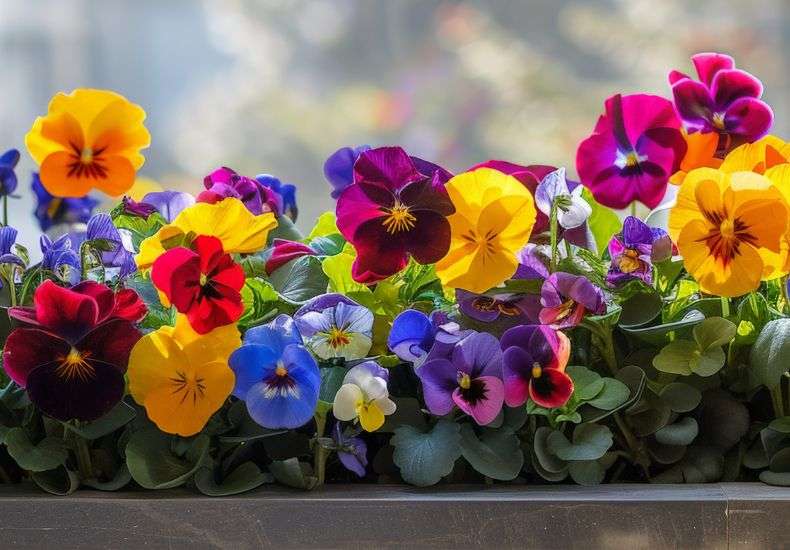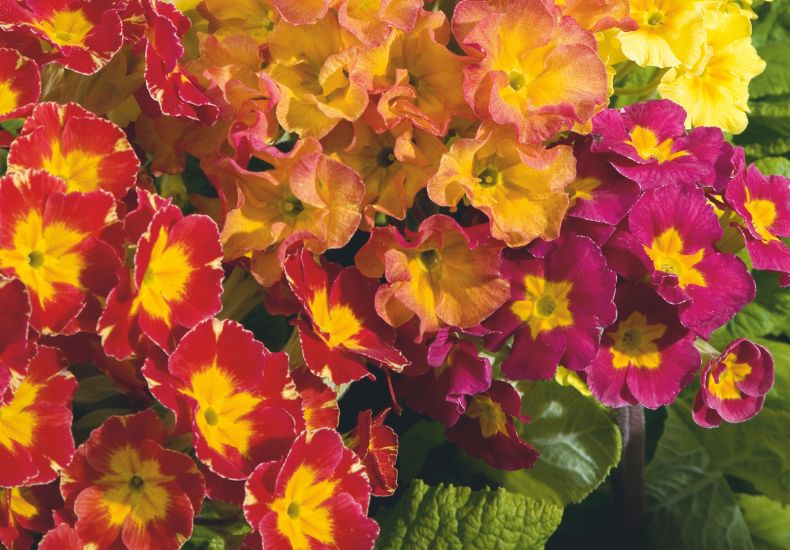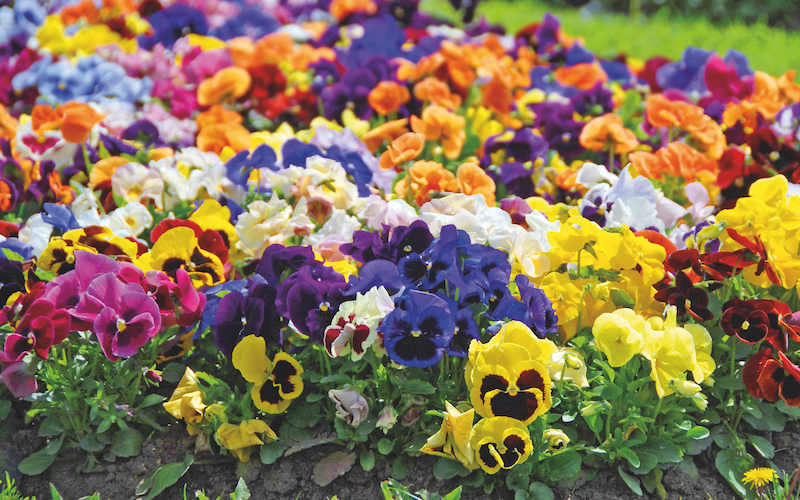It’s simple to cheer up your winter borders and containers with satisfying splashes of colour. All you need is a selection of fabulous winter bedding plants to plug the gap between late autumn and spring. Here, we’ve brought together the best independent articles, Instagram posts and YouTube videos showing you how to get the most from these beautiful winter flowers. Here’s how to use blooms like pansies, violas, primroses and bellis for all year round colour…
Contents:
- Best advice on where to plant your winter bedding
- Best advice on primulas for winter bedding
- Best advice on violas and pansies for winter bedding
- Best advice on winter bedding pests, problems and diseases
Best advice on where to plant your winter bedding

These low-maintenance pansies have enormous flowers in brilliant colours.
Image: Pansy ‘Giant Fancy Mix’ from Suttons (© Dreamstime)
Dan, the Frustrated Gardener, fills an awkward narrow border in the garden with a clever combo of winter bedding plants, spring bulbs and feature perennials for a fantastic show of colour from autumn through to spring. After planting the bulbs, he tops off the bed with pansies and violas, plus wallflowers and statement euphorbias.
Lots of gardeners hide their hanging baskets in the shed over the winter but, as Leigh at GreenTips Garden suggests, they can be used to great effect all year round. In his video he demonstrates how to use winter bedding plants to make a lovely hanging basket display. His choices are cyclamen, primula and viola, complemented by a statement decorative grass.
Raised beds and larger containers also make great homes for winter bedding plants, according to Katrina of Homegrown Garden. In a tour of the garden in January she shows how to plant up a raised bed and a galvanised planter with spring bulbs and an instantly attractive topping of winter bedding. She uses pansies and heathers in lovely pinks and purples, which provide interesting textures too.
Window boxes are another location where winter bedding plants can shine, especially in time for a festive Christmas welcome. Alexandra at the Middle-Sized Garden shares her lesson in how to plan a good looking winter window box using striking red cyclamen, with some more unusual plants to provide height, structure and contrast.
Swathes of natural looking wild primroses look great popping up throughout beds and borders, says Lewis aka @iplantsman. But he also loves to see them planted on damp banks near water, on open grassland, or the edges of woodland where they can spread themselves freely and happily. If you have a lovely sunny spot to fill he recommends bedding in some of his favourite Bellis perennis Bellisima Mix. He describes these as cheery, optimistic, easy-going, blousy and colourful bedding plants that shine in the sun from September to November before returning again in early spring.
You might not have thought of planting winter bedding in the rock garden, but Katharine, The Teabreak Gardener, advocates popping in some unfussy drumstick primulas for a bright winter focus. She describes them as shrugging off the cold weather like a polar bear!
In a chatty video over at Gardening at 58 North, the presenter demonstrates how he plants up two winter containers, teaming violas with ornamental cabbage. Watch as he gets some pansies and Cineraria maritima into the flowerbed for winter colour and checks out the showy wallflowers and primulas he planted the previous year.
Best advice on primulas for winter bedding

A colourful choice, ‘Springtide Mix’ primrose looks fantastic planted en masse in containers
Image: Primrose ‘Springtide Mix’ from Suttons (© Dreamstime)
Primulas are a big favourite, whether you prefer wild pastel-coloured primroses, the bold rainbow of hybrids or the crossover delights of polyanthus and drumstick varieties. Carol, the Sunday Gardener, likes to plant several different types and explains how best to grow each one in her comprehensive guide to primulas. She says they’re particularly happy in dappled shade and damp soil that’s not inclined to dry out.
Louise at Blooming Lucky plants new primroses every year to inject colour into her patio containers. In her post all about growing and using primulas, she reveals how she lifts the plants when they’ve finished flowering and shifts them to a shady bed in the garden, amassing a show-stopping number of primroses over the years.
Primulas come in a vast range of shapes and hues, but some are especially stunning, like the Zebra Blue primula picked out as a star turn by @katy_in_the_garden. She can’t get enough of its amazing dark blue and white markings (which she likens to Delft pottery) and sunny yellow centre.
You can never have too many primulas, says M. T. O’Donnell of The Pink Wheelbarrow, who selects the “drumstick” denticulata varieties as one of her six on Saturday choices. She regards them as heralds of spring as they burst into early flower in numerous areas where she has planted them to naturalise in the garden.
Once your winter bedding primulas are established, they can be keen self-sowers. Matt from @growlikegrandad reveals he’s been teaching his son how to recognise, lift and relocate primulas in the garden. He also shares a happy tale of neglect and success against the odds with a discarded primula.
Primroses are synonymous with cottage gardens, says Catherine at Growing Family who has fond memories of hunting for the first ones of the year in the woods when she was a child. She recommends you plant primroses under a tree in shaded, moist soil for a fabulous display in spring.
Michael, @mr_plantgeek, refers to primroses as the ultimate winter patio plant and shares a video tour of some favourite varieties. He also suggests planting intense primroses with striking black grasses for dramatic effect.
Best advice on violas and pansies for winter bedding

Glorious frilly raspberry-coloured blooms.
Image: Pansy F1 ‘Frizzle Sizzle Raspberry’ from Suttons
Cheeky-faced violas are the go-to winter bedding plant choice for Dan, the Frustrated Gardener who puts them at number one position in his top plants for winter containers. He says that although a really cold spell will stop them in their tracks, they burst into bloom again in spring to share their stunning colours and beautiful fragrance.
Alan from Down to Earth recommends planting your container pansies as soon as possible in autumn, so they come into flower quickly. “If you plant out pansies that haven’t started to flower, it’s my experience that they will often wait for the days to lengthen in the New Year, before they really start to bloom well.” He also recommends using fresh compost and a good quality, slow release fertiliser to give them a boost.
Becky at @sow_much_more fell for the delicate cuteness of violas when her grandmother bought her a plant as a child. Now she’s grown up, she sings her love for these winter bedding beauties from the rooftops and fills her garden with them, noting that they’re not just pretty – you can also eat them.
The toughness and dependability of both viola and pansy plants means they’re brilliant for cheering up the winter garden, according to Catherine of Growing Family. She says these ancient symbols of fertility and love make an excellent homemade gift when planted up in a pretty container.
Vibrant and undemanding pansies get the vote from Hema, at @growwithhema, who plants hers in a hanging basket in autumn to blossom in gorgeous colours through winter and into spring.
Best advice on winter bedding pests, problems and diseases

Polyanthus bring a welcome splash of colour to containers
Image: Polyanthus ‘Giant Thrill Mix’ from Suttons (© Branded Garden Products)
Winter bedding plants are notoriously easy to grow, but they do encounter the occasional problem. Primroses, for example, will tolerate almost any soil and like dampness, but they find it hard to cope with very soggy conditions and prefer peat-free soil, says Pumpkin Beth. Her top tip for keeping primroses in peak condition is to regularly snip off discoloured or damaged leaves close to the ground to encourage fresh foliage.
When growing pansies, “keep an eye out for green fly pests, especially on the undersides of leaves,” says Adam at his YouTube Channel, Adam’s Gardening Guides. Use an organic spray to treat any unwanted guests and keep your plants healthy through the winter, he says.
For pests and diseases that might affect your primulas and what to do about them, check out Simon at Garden of Eaden’s comprehensive list, including aphids, mosaic virus mould, mildew and rust. Finding tiny black spots on pansies and violas is bad news, he says, and if you see something is eating chunks out of your flowers overnight, he suggests seeking out and removing caterpillars, slugs, snails, or even earwigs.
It’s not only creepy crawlies that might take a fancy to the winter bedding plants in your country garden. Andrew at @andrewtimothyob speculates on what’s munching the primroses with a sorry image of nibbled flowers and leaves. He has a sneaking suspicion it’s rabbits – which will try eating anything once. Or could it be a badger?
As summer slowly spills over into autumn, it’s a great time to plan your winter garden and look forward to bright blooms to chase away the gloom when it’s cold and damp outside. We hope these expert tips help you to enjoy fabulous instant displays using some of our best bedding plants.
Lead image: Pansy ‘Matrix™ Mixed’ from Suttons
Last Updated on November 19, 2025 by Suttons Horticultural Team





